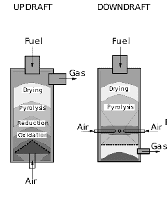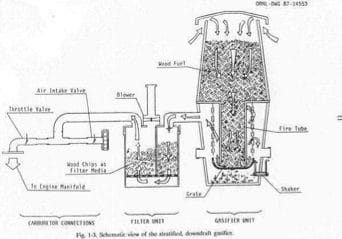Biomass Gasification
Biomass gasification is the process by which a usable fuel gas is created through the breaking down of solid biomass using heat. Burning wood only uses a third of the energy available and the other two-thirds of the energy goes up in smoke. This lost energy can be captured and used for additional heat and motor fuel.
The process is fundamentally different from producing biogas or methane fuel, as it uses a chemical rather than a biological process to create the gas, and wood gas production is much faster than biogas fermentation.
It requires more technical expertise to build a gasifier than it takes to build a methane digester, but if you have the skills to build one or resources to buy a relatively inexpensive one, you can have practically unlimited amounts of fuel and heat for all your on-farm requirements.
All you need is some carboniferous waste, knowledge, and a little maintenance…
How Does Gasification Work?
Biomass is burned in a simple stove-like reactor with limited oxygen, which results in only partial combustion of the biomass. This process gives off un-combusted gasses that can be captured for fuel.
This is a carbon-neutral, environmentally friendly fuel source if you use waste woods, managed forests, or coppices for your wood source. Coal, wood, paper, coconut husks, nut shells, charcoal and rice husks are all commonly used in gasification plants. If you have an easy source of waste wood or access to any of the wastes listed above, you, too, can heat power your home and mac hinery with biomass gasification.
Two common types of gasification reactors exist: Fluidized bed reactors, which are used in industrial production plants, and fixed bed reactors, which are easily constructed locally for small-scale home fuel production or bought from one of dozens of manufacturers online.
Wood Gasification In A Fixed Bed Reactor
There are two usual types of fixed bed reactor: updraft and downdraft.
Process
Biomass is combusted with restricted oxygen and the resulting gas contains the flammable gasses hydrogen (H2) 20%, carbon monoxide (CO) 20%, and a limited amount of methane (>10%). The remaining volume is made up of inert nitrogen.
When the resulting wood gas is burned in an engine or stove, the wastes from the process are carbon dioxide and water.
Gasifiers can be simple in design or more complicated. You will find some simple upgrades to the basic design, like in built burners to start the combustion, will save you significant time with frequent use.
The gold standard of the home gasifier design is the stratified downdraft gasifier:
Figure 1 – Copyright: FEMA
The gasifier has four main zones:
Zone 1: The top of the gasifier holds the fuel and allows air into the reactor. This acts as the fuel tank and may have to be refilled every few hours or as the fuel is used up.
Zone 2: Below the fuel storage the chemical reaction begins to occur. Heat causes the fuel (wood) and the oxygen in the air to react during pyrolysis, causing some limited combustion and produces charcoal and heat.
Zone 3: The fuel falls from Zone 2 to Zone 3 and the resulting thermochemical reaction causes the charcoal to convert to carbon monoxide and water vapor.
Zone 4: The ash and leftover charcoal bits from the reaction in Zone 3 fall into Zone 4, and when fully utilized fall through the bottom moveable grate to be removed and used as soil amendments.
Fuel Bridging / Channeling
While many high carbon fuel sources can be used, keep in mind that fine particles of fuel (saw dust, shredded wood, paper, etc.) can fail to fall between the zones and end up clogging the reactor. This clogging is called channeling or bridging.
This problem can be solved by installing a simple shaker or agitator to shake the fine particles of clogged fuel loose. A simple handle agitator for the bottom grate works fine. On vehicle-mounted gasifiers, this problem is overcome by the shaking of the vehicle as it drives.
Vehicle-Mounted Gasifiers
 Mounting a gasifier on a vehicle allows for nearly limitless driving time, requiring only a suitable fuel source on the way. In terms of sustainability or self-sufficiency it is a marvelous step in the right direction.
Mounting a gasifier on a vehicle allows for nearly limitless driving time, requiring only a suitable fuel source on the way. In terms of sustainability or self-sufficiency it is a marvelous step in the right direction.
Vehicle-mounted gasifiers will never be as convenient to use as a gasoline-powered vehicle with access to fuel, as some stoking is necessary, but they do grant you independence from foreign oil.
It should be possible to find suitable fuels on your way, but if not, you can easily bring wood chips with you (like locomotives used to do with coal).
Stationary gasifiers can be used to provide heat from the combustion process and the resulting gas can be burned for heat or refrigeration and can be used to power generators or motors with little maintenance to the gasifier or the consuming engine.
Alternatively, the gas could be compressed and used to fuel your vehicle like LPG powered buses and trucks.
Disclaimer: Wood gas is flammable and care should always be taken when handling it. Never smoke close to your reactor and make it sure is located in a well-ventilated place. Carbon monoxide is poisonous.

